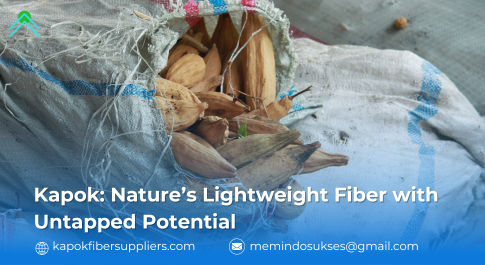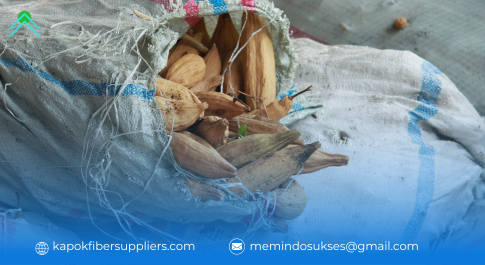
Kapok: Nature’s Lightweight Fiber with Untapped Potential
In the quest for sustainable materials, many have turned to well-known options like bamboo, hemp, or cotton. However, there’s a lesser-known natural fiber that deserves attention: kapok. Derived from the seed pods of the Ceiba pentandra tree, kapok is a remarkable material with a long history that has often been overshadowed by more popular fibers. This article explores why kapok is an eco-friendly game-changer that could transform industries ranging from textiles to packaging.
What Makes Kapok Different?
Kapok is a fiber that comes from the seed pods of the tropical kapok tree. Unlike cotton, its structure is unique: the fibers are hollow and filled with air. This gives kapok its signature lightness and buoyancy. Traditionally, kapok has been used in products like pillows, mattresses, and life jackets, but its potential goes far beyond these common applications.
The unique structure of kapok fibers gives them several impressive characteristics:
- Lightweight: Kapok is one of the lightest natural fibers available, making it an ideal choice for products that need to be comfortable without being heavy.
- Buoyant: Due to its air-filled fibers, kapok is naturally buoyant, which historically made it an ideal material for life jackets.
- Water-Resistant: Kapok’s fibers resist moisture, which helps it maintain integrity in humid conditions. This property makes it long-lasting and versatile.
- Hypoallergenic: Because it doesn’t contain synthetic chemicals, kapok is a great alternative for people with sensitivities or allergies.
The Untapped Potential of Kapok
Although it has been used in pillows, mattresses, and safety devices, kapok’s broader potential remains largely unexplored. As industries continue to seek environmentally friendly alternatives to synthetic products, kapok could play a key role. Here are some exciting and innovative ways kapok could be used:
- Sustainable Fashion: Kapok’s soft and lightweight nature makes it a promising alternative to traditional cotton, especially in warm climates. Researchers are exploring ways to process kapok into threads suitable for textiles and fabrics, potentially leading to a line of eco-conscious clothing that would reduce reliance on resource-heavy fibers like cotton or synthetic materials.
- Eco-Friendly Packaging: The global push for reducing plastic waste has led to a search for biodegradable alternatives in packaging. Kapok could step in to replace plastic peanuts and foam packaging, offering a lightweight and biodegradable material for protective packaging. Unlike plastic, which lingers in landfills for centuries, kapok fibers break down quickly without leaving harmful residues.
- Green Building Materials: Kapok’s insulating properties are ideal for use in construction. In addition to being lightweight, it’s a natural insulator, keeping buildings cooler in hot climates and helping with thermal regulation. As sustainable building practices gain traction, kapok could be incorporated into eco-friendly insulation, contributing to more energy-efficient homes and offices.
- Medical Uses: Kapok’s softness, lightness, and hypoallergenic nature make it a promising material for medical applications. It could be used in cushioned medical devices, wound dressings, or even as a natural filling for prosthetics. With its high resistance to bacteria and mold, kapok may have significant potential in health-related industries, particularly in areas that require non-toxic, safe materials.
- Biodegradable Plastics: Another emerging application for kapok is in bioplastics. The fiber can be processed into a biodegradable form, reducing the reliance on petroleum-based plastics. Kapok-based bioplastics would provide an eco-friendly solution for a wide range of products that require plastic-like durability but with a fraction of the environmental impact.
Environmental Benefits of Kapok
The environmental impact of kapok goes beyond just its low carbon footprint in production. The Ceiba pentandra trees themselves play an important role in carbon sequestration. These trees naturally absorb carbon dioxide as they grow, which helps reduce the overall carbon levels in the atmosphere. Kapok trees also do not require fertilizers or pesticides to thrive, making them a sustainable crop with minimal environmental impact.
In addition, the harvesting process for kapok is far less destructive than that of other natural fibers. Kapok is gathered by hand, and the tree is not harmed in the process. This sustainable harvesting method ensures that kapok production does not contribute to deforestation or habitat destruction, unlike the cultivation of other crops like cotton.
Overcoming Challenges to Widespread Use
Despite its many benefits, kapok faces some challenges in gaining widespread adoption. One significant obstacle is the lack of large-scale infrastructure for processing kapok fibers. The delicate nature of kapok fibers also makes them more difficult to handle compared to other fibers, requiring specialized equipment and techniques for extraction.
Another challenge is the limited awareness of kapok’s potential. Many industries remain unaware of this natural fiber and its benefits, focusing instead on more established materials. Increased research and development in kapok processing, as well as education on its environmental and practical advantages, will be crucial to expanding its use.
The Future of Kapok: A Fiber for a Sustainable Future?
As the world continues to shift toward sustainable practices, kapok has the potential to become a key player in the move toward more eco-conscious industries. Its unique properties—lightweight, buoyant, water-resistant, and biodegradable—make it an excellent candidate for replacing synthetic fibers and plastics in various applications.
With increasing demand for sustainable materials, businesses are beginning to recognize the potential of kapok. As innovations in processing and product design continue, kapok’s role in the future of sustainability is poised to expand. From fashion to packaging, from construction to medical devices, kapok could become a cornerstone of eco-friendly innovation in the coming decades.
Conclusion
Kapok is more than just a soft and fluffy fiber; it’s a resource with the potential to revolutionize industries, reduce environmental impact, and offer sustainable alternatives to synthetic materials. From its biodegradable nature to its lightweight, water-resistant, and buoyant properties, kapok is a versatile material that could help drive the transition to a greener, more sustainable world. As research and awareness of kapok continue to grow, we may soon see this natural fiber playing a much larger role in shaping the future of sustainability.

